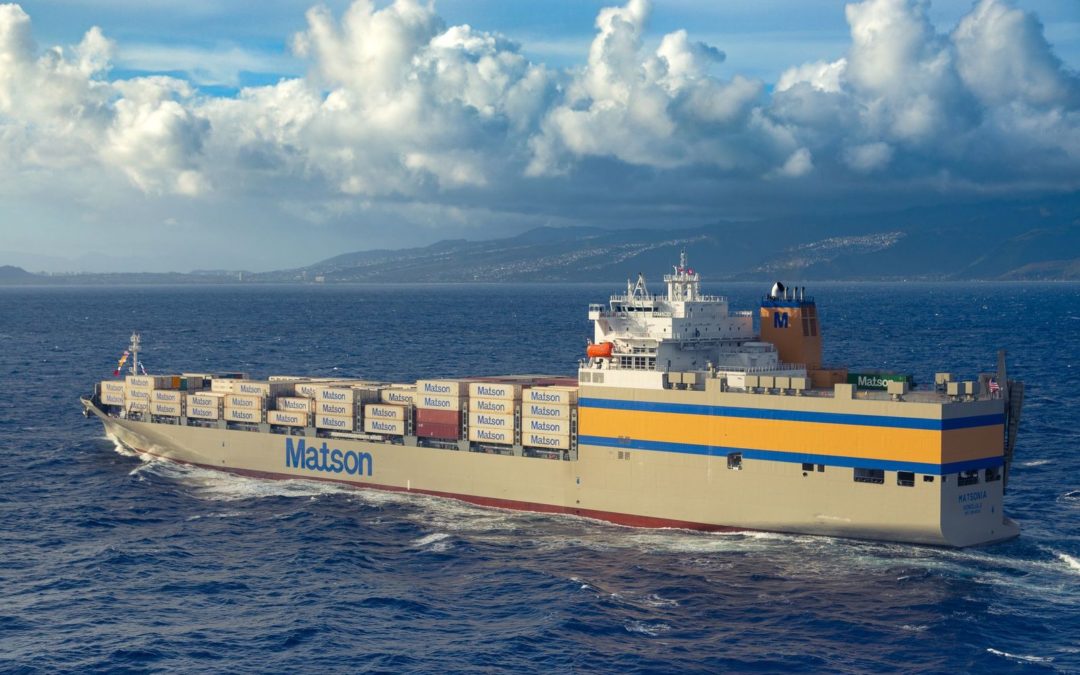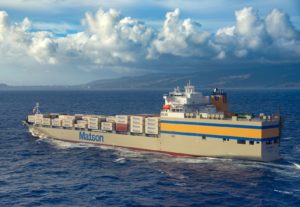Photo: Matson
By Stas Margaronis
The United States needs a national maritime strategy to identify commercial, shipbuilding, manpower and military sealift shortfalls as well as solutions, according to officials from the Transportation Institute and the Navy League of the United States.
Sara Fuentes, Vice President of Government Affairs, Transportation Institute and Jonathan Kaskin, National Vice President for Legislative Affairs, Navy League of the United States said that the DOT’s U.S. Maritime Administration (MARAD) and DHS’s U.S. Coast Guard is authorized to produce a National Maritime Strategy that would provide the basis for the United States to assess maritime shortfalls and address them through greater investment and/or policy changes.
They say that safeguarding U.S. protections of Jones Act carriers, builders and mariners, is vital as their livelihoods are coming under attack by conservative free-trade think-tanks such as the Cato Institute and the Heritage Foundation which ignore the economic and national security benefits of cabotage. These organizations represent an anti-federalist movement within the United States that is undermining the maritime security of the United States as China poses a growing threat to Taiwan and U.S. allies in the Pacific.
Military Sealift Commander Warns of Shortage of Ships & Mariners
In October of 2022, the Commander of the Military Sealift Command (MSC) Rear Adm. Michael Wettlaufer, warned that MSC continues to face a shortage of both ships and sailors, and it will take a “collective effort” from government and industry to turn the tide.
Wettlaufer was speaking at an event hosted by the Navy League of the United States.
Rear Adm. Wettlaufer noted that after the number of U.S. mariners reached their peak during World War II at 262,000, their population has plummeted to a fraction of that today — about 33,000 between 2018-2021. With recruitment and retention a problem across all of the services, MSC faces no easy solutions.
“Specifically, the top challenges currently facing MSC in this area are an atrophied maritime industry, a reduced U.S. flag commercial fleet and a shortage of ocean-going mariners,” he said.
To address the issue of a lack of vessels, Wettlaufer said MSC will seek to incentivize commercial participation.
“We’ve got to incentivize U.S. flagged shipping,” he said, noting that the number of U.S. flagged ships at their disposal had declined from 282 at the start of this century to 178 today. “On the production side, it’s great; we’re building ships. But we certainly need more.”[1]
The Navy League’s Kaskin said that he believes the crisis Wettlaufer described adds more urgency to producing the National Maritime Startegy as soon as possible:
“What we need is for the White House to make a National Maritime Strategy a top priority that will mobilize national resources to get the job done.”
Both Fuentes and Kaskin are worried that the decline in U.S. shipping and shipbuilding has gone on for so long that the issue lacks a national urgency.
Navy League Priorities
In the Navy League’s Maritime Policy Paper 2023-2024, it states:
“The U.S.-flag Merchant Marine, the umbrella term for all civilian government-owned and commercial ships under the U.S. flag, is the unseen foundation of our economy and armed forces. National Security Directive 28 (NSD 28) calls for the government to ‘ensure that the U.S. maintained the capability to meet sealift requirements in the event of crisis or war,’ and we are currently falling short of that goal. Government-owned sealift fleet capacity and readiness has fallen to dangerous levels and tanker capacity is severely limited. U.S. mariners are the best in the world, trained at the national Merchant Marine Academy, six state academies and unlicensed schools, but the inventory post-COVID is barely sufficient to operate the peacetime fleet. The Maritime Administration (MARAD) estimates our nation would require an additional 1,839 mariners in the event of a prolonged crisis. There are many options available for building the health of the fleet, and the U.S. Maritime Transportation System, but they will require attention and investment from the nation. Given that these investments will safeguard 30% of gross domestic product and over 650,000 jobs (according to figures from the American Maritime Partnership), the Navy League believes that the return on investment is more than sufficient.”[2]
Kaskin notes “Since the end of the Cold War, we have gone from 20 shipyards to 8 shipyards while China is the world’s leading shipbuilder. We see China subsidizing shipping, shipbuilding, and port development.”
To bolster Kaskin’s argument, a U.S. Naval War College report warned that the People’s Liberation Army Navy (PLAN), does not currently have the amphibious capacity to make an invasion of Taiwan possible, but will soon have that capability.
At the same time, shipbuilding orders by foreign carriers and technology transfers are aiding the competitiveness of Chinese commercial shipbuilding as well as the efficiency of naval warship construction, according to a Center for Strategic and International Studies (CSIS) report.[3]
Kaskin notes, U.S. flagged ships account for less than 2% of the global shipping fleet.
One of the few protections the U.S. maritime industry has left is the Jones Act which protects U.S. built ships and U.S. crews in the U.S. domestic and coastal trades, he said.
Attacks On The Jones Act
Two conservative based think tanks have taken prominent roles in attacking the Jones Act. Both organizations oppose the role of the federal government in a way that Kaskin and Fuentes feel undermines national and economic security.
In a Google search, here are two reports generated by Cato and Heritage:
Cato Institute: The Jones Act: A Burden America Can No Longer Bear
https://www.cato.org/publications/policy-analysis/jones-act-burden-america-can-no-longer-bear
Heritage Foundation: Deep-Six the Jones Act
https://www.heritage.org/trade/commentary/deep-six-the-jones-act
Kaskin says the effect of attacks on the Jones Act is to undermine maritime security at a time of growing tensions with China:
“Cato and Heritage ignore the economic and national security benefits to the United States when they seek to undermine the Jones Act at a time of the growing maritime threat from China. Focusing only on economic costs without acknowledging the public benefit of the Jones Act is disingenuous when there is such an overwhelming threat to national security and a growing naval and economic security threat to the United States in the Pacific. We can no longer afford to ignore these growing national security threats and the Jones Act is one way we protect our national security.”
Wall Street Journal Says Jones Act Unconstitutional
Both were particularly critical of a Wall Street Journal opinion piece calling for the dissolution of the Jones Act citing a ‘Port Preference Clause’ which is based on a states’ rights formulation and echoes Cato and Heritage criticisms.
The article which appeared on April 24th was entitled: “The Jones Act Is Unconstitutional Revive the Port Preference Clause to kill this ancient and destructive special-interest law.”
The Wall Street Journal article was written by a federal law clerk named Sam Heavenrich who concluded that:
“In purpose and effect, the Jones Act has carved out a market for the domestic shipping industry at the expense of citizens living in the noncontiguous U.S. But the Jones Act is more vulnerable than it appears. A constitutional challenge to the Jones Act could bring relief to those on America’s geographic peripheries who, like the Port Preference Clause, have been ignored for too long.”[4]
Fuentes and Kaskin says that the U.S. maritime industry is supported by the Jones Act as an infrastructural and national security asset that provides the major source of manpower to crew the ships of MARAD’s Ready Reserve Force and the U.S.-flag fleet during a protracted war time emergency when commercial and military supply chains will be contested . It also helps maintain a shipbuilding industrial base needed to support wartime ship battle-damage repair and construction. Jones Act opponents ignore this and argue instead that profit and cost should take precedence over the national interest, Fuentes and Kaskin argue.
National Maritime Strategy
In 2022, U.S. Senators Maria Cantwell (D-Wash.), Chair of the Committee on Commerce, Science, and Transportation, and Ranking Member Roger Wicker (R-Miss.) introduced the bipartisan U.S. Maritime Administration (MARAD) Reauthorization Act. They argued that the $1.6 billion bill would invest in the maritime workforce, strengthen maritime infrastructure, and expand research and development into new technologies to advance fleet sustainability and innovation.
The Bill requires a new National Maritime Strategy to help grow the maritime economy through shipbuilding, maritime trade, training and infrastructure.
“This bill makes critical investments in America’s maritime workforce, shipyards and port infrastructure that are key to keeping our supply chains moving,” said Sen. Cantwell. “It will create a new innovation center to explore cleaner fuels and new technologies to boost resilience of our maritime fleet and ensure the U.S. maritime industry remains competitive well into the future.”
“A strong Maritime Administration is essential for our national and economic security. I am glad to support this bill, which would improve our marine highway system, help protect against sexual assault and harassment within our merchant fleet and at the Merchant Marine Academy, support maritime education, and reauthorize the port infrastructure development program,” Sen. Wicker said.
MARAD is the principal federal agency responsible for supporting the American maritime industry through financing, shipbuilding, workforce development and port infrastructure grant programs.[5]
Conclusion
Kaskin says that among the options to be considered in the forthcoming National Maritime Strategy should include:
Expand the “Jones Act” fleet with coastwise services of Dual Use Vessels (privately-owned commercial ships with military utility-installed national defense features). These Dual Use Vessels (DUVs) would alleviate congestion, road wear and pollution along the I-5/I-95/I-10 corridors in peacetime by carrying domestic 53-foot tractor trailers/boxes along these American Marine Highways (AMHs). A business case analysis done in 2013 estimated the externality benefits associated with DUVs amounting to $16-25M/ship annually compared to truck or rail equivalents. If these externality benefits could be monetized and if the Title XI Federal Ship Financing Program and the Capital Construction Fund are used to reduce the effective capital costs, the DUVs would likely be competitive without further government support.[6]
Expand the Maritime Security Program to meet less time sensitive sealift needs and fund an expanded “Tanker Security Program” to address the massive tanker shortfall required to support Naval and Air Force operations in a major Indo-Pacific War.
Create and implement new cargo preference programs such as the Energizing American Shipbuilding Act which would generate additional U.S.-flag and U.S.-built ships, help maintain the shipbuilding industrial base and provide crews for reserve fleet ships. This particular law would require a percentage of liquefied natural gas and crude oil exports be transported on U.S.-built, U.S.-flag ships. This would help stem the decline of U.S. shipping in foreign trade, boost mariner employment and provide additional work for U.S. shipyards.
FOOTNOTES
[1] https://seapowermagazine.org/rear-adm-wettlaufer-shortage-of-ships-mariners-an-ongoing-problem-for-military-sealift-command/
[2] https://www.navyleague.org/wp-content/uploads/2023/01/Maritime-Policy_2023_FINALv1.pdf, page 3
[3] https://rbtus.com/u-s-naval-experts-says-china-will-soon-have-the-capability-to-invade-taiwan/
[4] https://www.wsj.com/articles/the-jones-act-is-unconstitutional-port-prerference-clause-trade-supreme-court-shipping-ff9a6cf3
[5] https://www.commerce.senate.gov/2022/6/cantwell-wicker-introduce-marad-reauthorization-to-boost-investment-in-u-s-maritime-industry
[6] https://www.navyleague.org/wp-content/uploads/2021/10/Sealift-Capacity-Report.pdf


